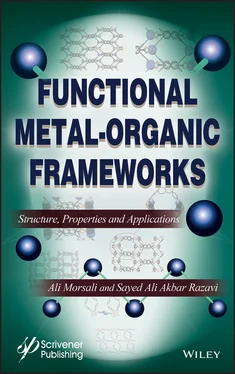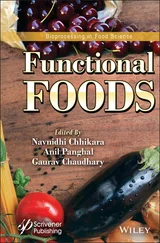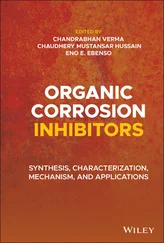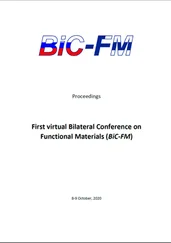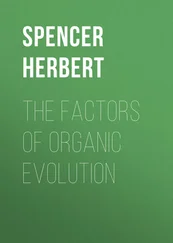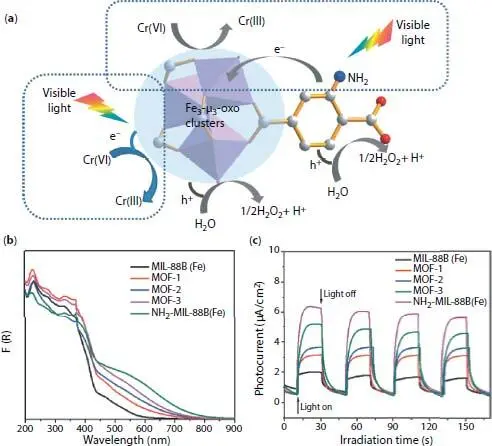
Figure 2.9 Application of MIL-88(Fe)-NH 2in photocatalytic degradation of Cr(VI). (a) dual pass mechanism in presence of amine functionalized ligand. (b) Diffuse-reflectance UV/vis spectrum of NH 2-MIL-88B(Fe) and MIL-88B(Fe). (c) Transient photocurrent spectroscopy of NH 2-MIL-88B(Fe) and MIL-88B(Fe) [47].
2.3 Function–Structure Properties
The majority of chemistry of an amine functionalized MOF is around their capability as guest-interactive sites in host-guest chemistry. Structural features of amine FMOFs depend on the amine type as primary, secondary or tertiary.
Primary amines (−NH 2) mainly applied as guest interactive site in the side chain of MOFs in tethered form [21, 22]. Anyway, sometimes primary amines are able to coordinate to metal ions during self-assembly synthesis.
Secondary amines could be applied in both main chain and side chain (tethered form) of the MOFs. K. Mark Thomas and coworkers synthesized an amine FMOFs with secondary amine motifs (−NH−) in the main chain [51]. The freedom and rotation around C−N−C might give rise to flexibility of the MOF. Also, organic ligands based on secondary amines applied as V-shaped ligand for development of desired MOF [52]. In most of the time secondary amines in side chain applied for study about the Lewis basicity of the MOF for different applications [53–55].
Similar to secondary amines, tertiary amines could apply in side chain for study about the Lewis basicity of the MOF for different applications. Specific type of tritopic ligands based on tertiary ligands applied for construction of MOFs.
As we saw, amine function extensively applied with the aim of improvement in efficiency of MOFs in different type of applications. This attention is due to the fact that amine decorated MOFs benefits from several chemical features as well as easy synthesis method. Particularly, amine decorated MOFs show very good results in some application like carbon dioxide capture-release in post-combustion process. Also, they successfully applied for oil denitrogenation and detection of picric acid in aqueous solution. Though, amine decorated MOFs applied for energy and environmental purposes, but these achievements have to develop and tailor for real-life applications.
1. Vaidhyanathan, R., Iremonger, S.S., Shimizu, G.K.H., Boyd, P.G., Alavi, S., Woo, T.K., Competition and Cooperativity in Carbon Dioxide Sorption by Amine-Functionalized Metal–Organic Frameworks. Angew. Chem. , 124, 1862–1865, 2012.
2. Planas, N., Dzubak, A.L., Poloni, R., Lin, L.-C., McManus, A., McDonald, T.M., Neaton, J.B., Long, J.R., Smit, B., Gagliardi, L., The Mechanism of Carbon Dioxide Adsorption in an Alkylamine-Functionalized Metal–Organic Framework. J. Am. Chem. Soc. , 135, 7402–7405, 2013.
3. Vaidhyanathan, R., Iremonger, S.S., Shimizu, G.K.H., Boyd, P.G., Alavi, S., Woo, T.K., Direct Observation and Quantification of CO 2Binding Within an Amine-Functionalized Nanoporous Solid. Science , 330, 650–653, 2010.
4. McDonald, T.M., Lee, W.R., Mason, J.A., Wiers, B.M., Hong, C.S., Long, J.R., Capture of Carbon Dioxide from Air and Flue Gas in the Alkylamine-Appended Metal–Organic Framework mmen-Mg2(dobpdc). J. Am. Chem. Soc. , 134, 7056–7065, 2012.
5. McDonald, T.M., D’Alessandro, D.M., Krishna, R., Long, J.R., Enhanced carbon dioxide capture upon incorporation of N, N′-dimethylethylenediamine in the metal–organic framework CuBTTri. Chem. Sci. , 2, 2022–2028, 2011.
6. Demessence, A., D’Alessandro, D.M., Foo, M.L., Long, J.R., Strong CO2 Binding in a Water-Stable, Triazolate-Bridged Metal–Organic Framework Functionalized with Ethylenediamine. J. Am. Chem. Soc. , 131, 8784–8786, 2009.
7. Yeon, J.S., Lee, W.R., Kim, N.W., Jo, H., Lee, H., Song, J.H., Lim, K.S., Kang, D.W., Seo, J.G., Moon, D., Wiers, B., Hong, C.S., Homodiamine-functionalized metal–organic frameworks with a MOF-74-type extended structure for superior selectivity of CO2 over N2. J. Mater. Chem. A , 3, 19177–19185, 2015.
8. Lee, W.R., Jo, H., Yang, L.-M., Lee, H., Ryu, D.W., Lim, K.S., Song, J.H., Min, D.Y., Han, S.S., Seo, J.G., Park, Y.K., Moon, D., Hong, C.S., Exceptional CO2 working capacity in a heterodiamine-grafted metal–organic framework. Chem. Sci. , 6, 3697–3705, 2015.
9. Vaesen, S., Guillerm, V., Yang, Q., Wiersum, A.D., Marszalek, B., Gil, B., Vimont, A., Daturi, M., Devic, T., Llewellyn, P.L., Serre, C., Maurin, G., De Weireld, G., A robust amino-functionalized titanium(iv) based MOF for improved separation of acid gases. Chem. Commun. , 49, 10082–10084, 2013.
10. Lv, R., Wang, J., Zhang, Y., Li, H., Yang, L., Liao, S., Gu, W., Liu, X., An amino-decorated dual-functional metal–organic framework for highly selective sensing of Cr(iii) and Cr(vi) ions and detection of nitroaromatic explosives. J. Mater. Chem. A , 4, 15494–15500, 2016.
11. Wen, L., Zheng, X., Lv, K., Wang, C., Xu, X., Two Amino-Decorated Metal–Organic Frameworks for Highly Selective and Quantitatively Sensing of HgII and CrVI in Aqueous Solution. Inorg. Chem. , 54, 7133–7135, 2015.
12. Nagarkar, S.S., Desai, A.V., Samanta, P., Ghosh, S.K., Aqueous phase selective detection of 2,4,6-trinitrophenol using a fluorescent metal–organic framework with a pendant recognition site. Dalton Trans. , 44, 15175–15180, 2015.
13. Joarder, B., Desai, A.V., Samanta, P., Mukherjee, S., Ghosh, S.K., Selective and Sensitive Aqueous-Phase Detection of 2,4,6-Trinitrophenol (TNP) by an Amine-Functionalized Metal–Organic Framework. Chem. Eur. J. , 21, 965–969, 2015.
14. Das, P. and Mandal, S.K., Strategic Design and Functionalization of an Amine-Decorated Luminescent Metal Organic Framework for Selective Gas/Vapor Sorption and Nanomolar Sensing of 2,4,6-Trinitrophenol in Water. ACS Appl. Mater. Interfaces , 10, 25360–25371, 2018.
15. Ahmed, I., Khan, N.A., Yoon, J.W., Chang, J.-S., Jhung, S.H., Protonated MIL-125-NH2: Remarkable Adsorbent for the Removal of Quinoline and Indole from Liquid Fuel. ACS Appl. Mater. Interfaces , 9, 20938–20946, 2017.
16. Ahmed, I. and Jhung, S.H., Effective adsorptive removal of indole from model fuel using a metal-organic framework functionalized with amino groups. J. Hazard. Mater. , 283, 544–550, 2015.
17. Seo, P.W., Ahmed, I., Jhung, S.H., Adsorption of indole and quinoline from a model fuel on functionalized MIL-101: Effects of H-bonding and coordination. Phys. Chem. Chem. Phys. , 18, 14787–14794, 2016.
18. Gascon, J., Aktay, U., Hernandez-Alonso, M.D., van Klink, G.P.M., Kapteijn, F., Amino-based metal–organic frameworks as stable, highly active basic catalysts. J. Catal. , 261, 75–87, 2009.
19. Chen, J., Liu, R., Gao, H., Chen, L., Ye, D., Amine-functionalized metalorganic frameworks for the transesterification of triglycerides. J. Mater. Chem. A , 2, 7205–7213, 2014.
20. Verma, A., De, D., Tomar, K., Bharadwaj, P.K., An Amine Functionalized Metal–Organic Framework as an Effective Catalyst for Conversion of CO2 and Biginelli Reactions. Inorg. Chem. , 56, 9765–9771, 2017.
21. Ali Akbar Razavi, S. and Morsali, A., Linker functionalized metal-organic frameworks. Coord. Chem. Rev. , 399, 213023, 2019.
22. Lin, Y., Kong, C., Chen, L., Amine-functionalized metal–organic frameworks: Structure, synthesis and applications. RSC Adv. , 6, 32598–32614, 2016.
23. Zhang, Z., Yao, Z.-Z., Xiang, S., Chen, B., Perspective of microporous metal–organic frameworks for CO 2 capture and separation. Energy Environ. Sci. , 7, 2868–2899, 2014.
Читать дальше
